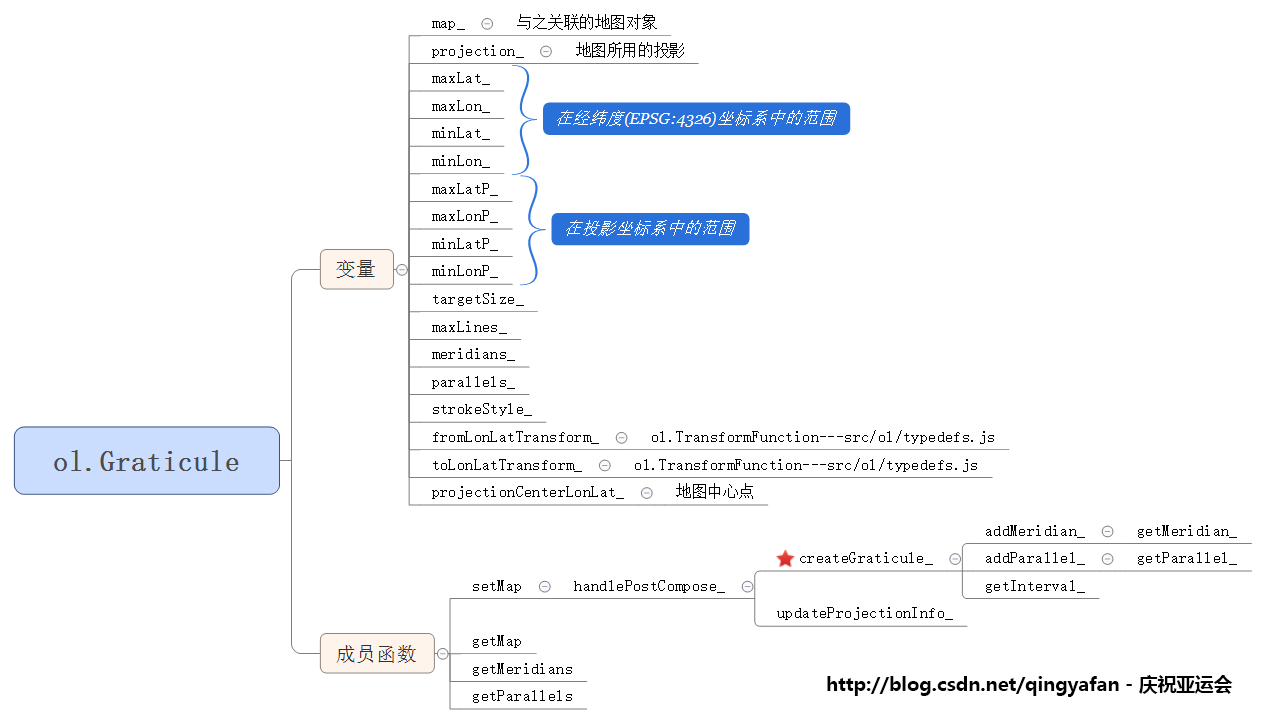OpenLayers 3 之 添加地图网格
目录
前言
在地图上渲染一层类似于经纬线的网格层,更有利于准确的确定区域,在WGS84坐标系下,以度,分,秒为单位,称之为“经纬网”,其网格是以经纬线来划分的。在OpenLayers3中,渲染网格的类是“ol.Graticule”。本文中,我结合实例,讲解“ol.Graticule”的用法和具体实现。
示例
初始化一个网格层,然后将其关联的map对象设置为map(预先定义好的),网格层便会在关联的地图上渲染。初始化网格层可传的参数和方法下面会说明,例子如下(完整的例子可以到我的GitHub查看):
var graticuleLayer = new ol.Graticule({
// map: map,
strokeStyle: new ol.style.Stroke({
color: 'rgba(12, 12, 12, 0.8)',
width: 0.6
}),
targetSize: 100
});
graticuleLayer.setMap(map);执行结果如下图:

使用
参数
初始化“ol.Gracule”时可调节的参数有四个(map,maxLines,strokeStyle和targetSize),如下:
- map 参数指定了网格层关联的地图对象,也可以不设置该参数,使用其setMap()函数;
- maxLines 指定以地图中心为参考,左右经线和上下纬线的最大数量,默认值是 100,这表示将绘制200条经线和纬线。需要注意渲染速度会随着maxLines的变大而下降;
- strokeStyle 指定线的样式,值是一个“ol.style.Stroke”对象,如果没有指定该参数,其默认样式是rgba(0,0,0,0.2);
- targetSize 指定每个网格覆盖的区域的大小,单位是像素,默认是100,也就是 10 像素 × 10 像素。
API
“ol.Gracule”对外开放的API也有四个,如下:
- getMap,取得与网格相关联的地图对象;
- setMap,设置与网格相关联的地图对象,网格将在关联的地图之上渲染;
- getMeridians,取得所有经线组成的数组,每条绘制的经线都是“ol.geom.LineString”对象;
- getParallels,取得所有纬线组成的数组,每条绘制的维线也都是“ol.geom.LineString”对象。
实现

OL3中的类构造都使用构造函数模式和原型模式,在构造函数中,除了赋值一些参数外,最后调用了“setMap”,setMap会对地图对象的“POSTCOMPOSE”事件绑定“handlePostCompose_”监听函数,“handlePostCompose_”做了所有初始化并渲染网格的工作。其中,“createGraticule_”做渲染工作,“addMeridian”和“addParallel”做实际的渲染经线和纬线的工作。
setMap
setMap定义如下:
<span style="font-family:Times New Roman;">/**
* Set the map for this graticule. The graticule will be rendered on the
* provided map.
* @param {ol.Map} map Map.
* @api
*/
ol.Graticule.prototype.setMap = function(map) {
if (this.map_) {
this.map_.un(ol.render.EventType.POSTCOMPOSE,
this.handlePostCompose_, this);
this.map_.render();
}
if (map) {
map.on(ol.render.EventType.POSTCOMPOSE,
this.handlePostCompose_, this);
map.render();
}
this.map_ = map;
};</span>setMap首先判断初始化时是否指定了“map_”参数,如果指定了,首先解除绑定地图对象“POSTCOMPOSE”事件的监听函数“handlePostCompose_”,如果指定新的地图对象,则对新指定的
map 对象,绑定`POSTCOMPOSE`事件监听函数“handlePostCompose_”,并调用
map 对象的 render 方法,最后将地图对象赋值给“this.map_”。从以上的类脉络图看,“handlePostCompose_”功能是初始化网格并渲染在地图上,并随着地图缩放等操作触发的“POSTCOMPOSE”事件,根据实际情况重新渲染。
addMeridian_&addParallel_
null),“getMeridian”实现如下:
/**
* @param {number} lon Longitude.
* @param {number} minLat Minimal latitude.
* @param {number} maxLat Maximal latitude.
* @param {number} squaredTolerance Squared tolerance.
* @return {ol.geom.LineString} The meridian line string.
* @param {number} index Index.
* @private
*/
ol.Graticule.prototype.getMeridian_ = function(lon, minLat, maxLat,
squaredTolerance, index) {
goog.asserts.assert(lon >= this.minLon_,
'lon should be larger than or equal to this.minLon_');
goog.asserts.assert(lon <= this.maxLon_,
'lon should be smaller than or equal to this.maxLon_');
var flatCoordinates = ol.geom.flat.geodesic.meridian(lon,
minLat, maxLat, this.projection_, squaredTolerance);
goog.asserts.assert(flatCoordinates.length > 0,
'flatCoordinates cannot be empty');
var lineString = this.meridians_[index] !== undefined ?
this.meridians_[index] : new ol.geom.LineString(null);
lineString.setFlatCoordinates(ol.geom.GeometryLayout.XY, flatCoordinates);
return lineString;
};ol.geom.flatgeodesic.meridian方法返回经线的坐标集合, lineString.setFlatCoordinates方法将lineString坐标设置为flatCoordinates,这样就完成了一条经线的初始化。
总结
转载自:https://blog.csdn.net/qingyafan/article/details/51540358




